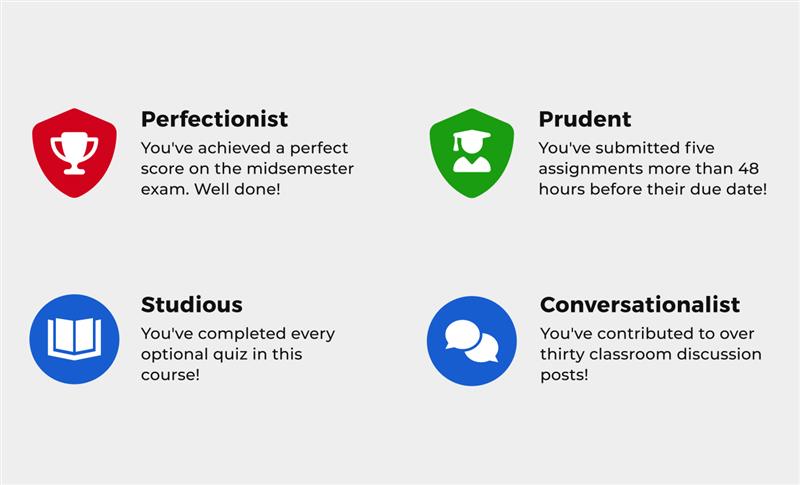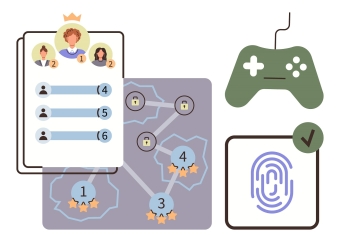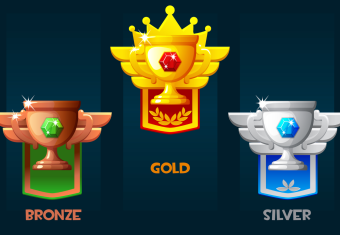Although developing a new skill set is often incredibly rewarding, the learning process can feel – at times – effortful, tedious, and demotivating. Gamification has become a popular method to address this challenge over the past few decades. By implementing fun, engaging features from game design into an established curriculum, gamification aims to incentivise students through encouraging and rewarding their course interactivity. Digital badges are one of the most common forms of gamification utilised in learning today – but what are they, and are they always appropriate for a course?
What are badges?

Digital badges are supplementary awards conferred to students upon the successful completion of tasks or certain criteria. These are displayed as graphical icons on a student’s online profile, often accompanied by a description of how the badge was earned, serving as a visual representation of their progress and achievement. Their intent is to extrinsically motivate students by providing an additional reward, ideally encouraging them to complete tasks they would not otherwise.
Though gamification has been widely demonstrated to have positive effects (Hamari et al., 2014), these same studies conclude that its potential benefits vary greatly depending on both users and the context of its implementation. Badges are no exception – their efficacy as a potential motivational tool are explored below.
Personality Type
Studies have discovered that a student’s psychological profile greatly impacts the usefulness of badges on their learning. Hakulinen and Auvinen (2014) found that students motivated to learn by extrinsic indicators, such as grades or feedback, responded very positively towards badges and saw a notable increase in their performance. This result is unsurprising – this category of “mastery-extrinsic” students, who are driven by external validation, are likely to be more receptive to yet another form of it (interestingly, this applied even if badges were not made public).
In contrast, students classified as “performance-avoidance” – those that are afraid of being seen performing poorly – reacted significantly worse to the implementation of badges. For these students, badges were not motivating. This trend also applies to students who tend to avoid course participation where possible. However, even students who are more intrinsically motivated still tend to value the implementation of badges to some degree.
In short, badges do not help students universally. Students who are (at least in part) driven by extrinsic motivators both enjoy badges and obtain better results when they are implemented, but a significant portion of students are either unaffected or might find them actively detrimental and distracting to their learning experience. Badges, therefore, must be applied carefully and appropriately to ensure that a greater majority of students reap their benefits – but how might this be done?
Curating Badges
Users do not just respond to badges in general – they respond differently depending on how and which badges are used. Nicholson (2012) states that “situational relevance” is key for what he terms “meaningful gamification”. Paraphrased simply, gamification methods must be tailored for both the variety of users and the goals of the learning structure they are implemented within. He asserts that gamification as an extraneous motivator is enough to drive some people to perform tasks that they have low motivation towards otherwise – so long as the user finds the additional gamification usage relevant and meaningful.
For example, Abramovich et al. (2013) found that high-performing and low-performing students benefit from different types of badges. For high-performing students, badges that rewarded quantifiable performance served as additional motivation, but for low-performing students these did not. Instead, low-performing students responded to badges that rewarded participation, not mastery.
Clearly, students have differing needs. Masters’ students might respond well to badges predicated on performance but find participation or time-management badges patronising. Conversely, struggling high-schoolers might experience the inverse – mastery badges may feel confronting or demoralising, whereas rewards for the completion of even simple tasks might prove to be the encouragement they need to keep pushing through adversity. There is no one-size-fits-all application of badges – they must be utilised with nuance, and doing so requires a thorough understanding of both the course and its participants.
There are many kinds of badges – examples might include badges rewarding engagement, skill, compliance, prudence, and many more. Moreover, badges can (and should) be customised to best fit specific course structures. When designing badges, it is important to consider their congruence: for example, badges rewarding consistent long-term engagement might make more sense in a lengthy curriculum than in a short intensive course. The same logic applies when considering the type of course content; different subject matter might require different motivational priorities.
Wrapping Up
Badges have been proven to provide net motivational and performance benefits when utilised correctly – even for students who are relatively apathetic towards extrinsic motivations. Ultimately, however, badges must feel meaningful, not performative. Students who view badges as superficial are unlikely to be motivated by them. This is especially true for the proportion of students who seek to minimise effort, or who may be struggling in the classroom already and view any additional challenge as unwelcome.
Due care must be taken when designing badges; competitive, high-performing cohorts are more likely to thrive on performance-rewarding badges than avoidant, low-participation students, who may instead benefit from other motivational sources.
Nevertheless, it is worth reiterating that the net benefits of digital badges may outweigh the potential downsides for this relatively small proportion of students – especially since badges can be customised and curated to fit the particular needs of specific courses or cohorts.


